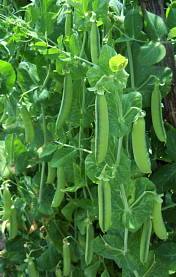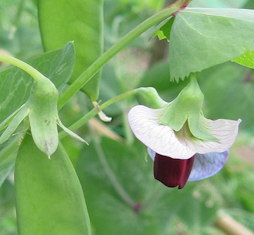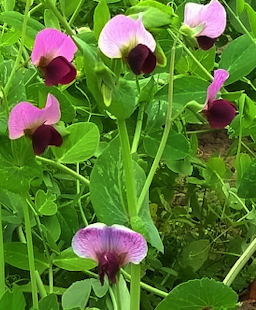~ Seed for PEAS ~
We want varieties that are really tasty, as well as productive.
Peas are sown in spring - they're pretty hardy, and we sow our first ones in modules in a cold greenhouse in February , planting them out as soon as they're an inch or so high (if you sow outdoors, mice tend to steal the seed). In mild areas, you can also sow hardier varieties in autumn for early crops the next year, though we've found that a spring sowing usually catches up and crops only a little later.
Small screen: Turn your device sideways to view sowing calendar.




















































 = normal sowing & harvest time
= normal sowing & harvest time![]()
 = also possible depending on conditions
= also possible depending on conditions
Tall peas are are a little more work in that you need to provide supports,but you get a much, much bigger yield from a given space. Beware that some of the older varieties will grow to 6 foot plus in fertile soil!
~ Dwarf Pea Seed ~
Dwarf peas are earlier to crop than tall peas, and are a bit easier to grow, especially in windy areas, as they don't need such a big and strong support structure - although they will still need some netting or finely branching twigs to climb. If you just grow them without any support the pods will lie on the ground and get eaten by slugs or damaged by wet.


Oskar VERY, VERY EARLY
A favourite from our 2011 trials, this is a first-early variety from the Czech Republic. Dwarf plants about 3 ft tall that make extremely sweet peas right at the start of the season. It has nice dark healthy foliage and bears a decent number of pods.
You'll want to successional sow or grow some other peas as well, as its so early that it finishes by the start of summer, but it is great for delicious peas before any others crop.
It really stands out in terms of how quickly it makes peas, and has a great taste as well - both fresh and cooked.
![]() approx 150 seed £
approx 150 seed £
Stock:
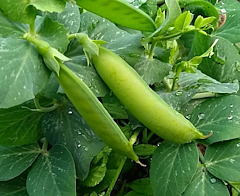 American Wonder TRULY DWARF
American Wonder TRULY DWARF
At least 150 years old, this is a remarkably early and dwarf variety from the mid 1800’s. It grows just 20” tall or less, requiring very little support, and it makes large crops of really fat pods just stuffed with sweet peas.
 Already popular by the time the english edition of ‘The Vegetable Garden’ was published in 1885, where it is the first entry for dwarf peas. Ours match the description perfectly!
Already popular by the time the english edition of ‘The Vegetable Garden’ was published in 1885, where it is the first entry for dwarf peas. Ours match the description perfectly!
![]() approx 150 seed £
approx 150 seed £
Stock:
Kelvedon Wonder
This is one of the best second-early dwarf peas to grow in the UK. Originating in Essex about 120 years ago, it has good natural disease resistance and makes heavy crops of sweet peas, 8 seeds per pod. It grows to about two foot tall but will really benefit from some support either pea netting or twiggy sticks.
A second sowing in mid-late June will give you a second crop later in the season.
![]() approx 125 seed £
approx 125 seed £
Stock:
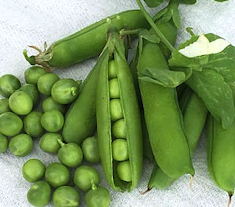
Extra-Early Pedigree EXCELLENT FLAVOUR
This variety was selected out of 'Extra Early' way back in 1893 by the Kenney Seed Co. Then it was stabilized and introduced around 1900 and distributed by several seed houses, considered “the best strain of Extra Early ever offered.”
This grows just 2ft tall and requires minimal support. We really liked this one in our trials last year - it has an excellent flavour.
![]() approx 150 seed £
approx 150 seed £
Stock:
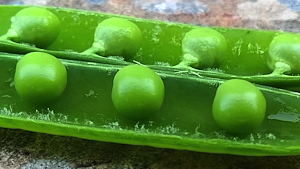 Feltham First
Feltham First
A real heirloom, this is one of the earliest varieties. You can sow it in spring as usual, but it is also a very hardy plant and in milder areas it is also worth trying a November sowing for very early harvest at the start of the following year.
Originally from Mr A.W. Smith’s renowned seed company based in the fields of Feltham, in what was then rural Staines in the late 1800s. Now swallowed up by urban Hounslow, his fields and impressive glasshouses all along Feltham High Street are gone but his pea lives on and is still a favourite among home gardeners.
![]() approx 120 seed, £
approx 120 seed, £
Stock:
~ Climbing Pea Seed ~
Climbing peas are a bit more work, as you have to put up a sturdy five or six-foot tall frame and some netting that won't blow over in storms - but you then get more peas from a smaller space. We have collected some really good varieties for you.
![]()
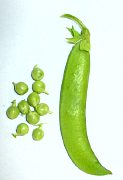 Serpette Guilloteau
Serpette Guilloteau
A traditional climbing pea, to 1.5 m high, with curved pods full of fat green peas. The name is from the French for a special type of pruning knife, reflecting the remarkable sickle-shape of the pods!
Classed as ‘semi - early’ this makes a good second-early or maincrop pea. It has smooth (rather than wrinkled) seeds, so it can be autumn or early spring without risk of rot, but pick small for sweetness.
Fast growing, curved pods, slightly flattened sweet peas. Now very rare, we are producing here in Pembrokeshire whenever possible.
 approx 80-85 seed
£
approx 80-85 seed
£
Stock:
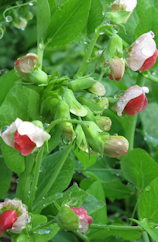
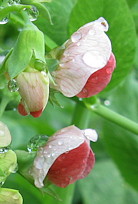 Rosakrone
Rosakrone
A very unusual heirloom from Sweden, withs beautiful red/pink flowers borne in 'crowns' above the foliage.
It grows to around 4 - 5 foot tall, and looks stunning on a wigwam or peasticks for a decorative feature that also produces lots of tasty peas. Given to us by Vivi Logan, we are delighted to add this to our collection.
Clusters of flowers! Grown by us in Pembrokeshire.
 approx 50-55 organic seed (very rare!) for
£
approx 50-55 organic seed (very rare!) for
£
Stock:
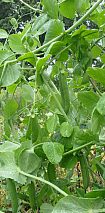 Telephone Pea (very tall)
Telephone Pea (very tall)
A well known and much loved tall pea - six foot plus - that we recommend as an early-maincrop pea. It hasn't really changed from the description of 'Carter's Telephone Pea' in Vilmorin's famous book of 1885 on vegetable gardening.
It has heavy yields of large pods with sweet, non-starchy peas inside. We find that the pods always swell up a bit before the peas fill out, so don't be fooled into picking too early! We find it's best to check a couple of pods first before picking lots - not too much of a hardship!
Wrinkled seed, stays sweet longer in pods - but don't sow in cold wet conditions.
![]() about 140-150 seed
£
about 140-150 seed
£
Stock:
(We checked up: the word 'telephon' (without the e) was indeed in use by 1854 to describe an effect supposedly seen when people were given electro-shock treatment and their cries were transmitted over the wires they were holding. The first patent for what we know as a Telephone was in 1876 by Bell, and we assume Mr Carter called his pea after that rather than the earlier meaning!)
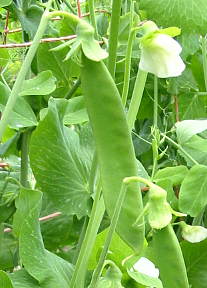 "Champion of England " Tall Pea
"Champion of England " Tall Pea
Re-introduced by us in 2010. The conclusion of a 4-year rescue project, here is your chance to grow a traditional UK variety that has been commercially extinct for years.
A really good, traditional tall pea to 8 - 10 ft, dating from the 1840's. But it was unavailable, other than seedbanks, for a long time. A few people sent us small samples of seed from time to time, but we couldn't get them to grow. All that changed though when Robert Woodbridge got in touch with family-saved seed from Lincolnshire in the 1940's.
It grew really well, and more importantly, was true to the old descriptions. It was fantastic - the only reason tall peas have been abandoned commercially is that you can't harvest them with machines. But for home gardeners, they give a great return for a small space.
So, after a few seasons, we have bulked it up from his original handful, and it available for you to try. We think you'll like it just as much as we do.
We'll let him give the history in his own words:
She got the seed from the head gardener at a big country house during the war where my grandfather worked as a carpenter repairing wooden greenhouses and cold frames.
As to the pea it grows to ten foot high and the peas are 8 to 10 per pod and you start picking from the bottom and work your way up, it prefers to be sown at the end of April to avoid the pea moth maggot and takes about 100 days to reach 10 ft.
An amazing find- the genuine tall strain, well maintained over the years, and we even know the location it came from. Robert's grandmother would have been pleased to know her seeds have saved this variety for gardeners everywhere.
Practically extinct until we rescued it. As it is (like all our seeds) real seed - not a hybrid - you can of course keep your own seed for resowing.
![]() approximately 120 seed
£
approximately 120 seed
£
Stock:
Another variety we rescued - a fantastic traditional UK pea that is sadly commercially extinct, but we managed to regenerate it starting with just a tiny handful of peas which we tracked down in a private seed collection in USA.
So here you are, a wonderful old pea brought back from the verge of extinction. It grows to about 5 or 6 ft tall, and the special thing about Lord Leicester is that starts to flower very early on, but carries on to almost the end of the season - so you get peas over a long period. The yield is good too - just look at all those pods in the picture!
As far as we know, this is now extinct, other than our crop - hence the smaller packet. But 60 or so seeds should be plenty to be honest, as it is really productive. And as it is (like all our seeds) real seed - not a hybrid - you can of course keep your own seed for resowing.
 60-70 seed , organic
£
60-70 seed , organic
£
Stock:
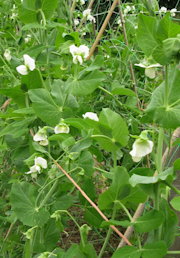 "Magnum Bonum" Tall Pea
"Magnum Bonum" Tall Pea
We are absolutely delighted to have Magnum Bonum available again. The really notable thing about this variety is its fantastic flavour. It is somewhat later to flower and produce pods than our other tall peas - you'll need to wait 2-3 weeks longer to get your crop. But it is very much worth the wait - the peas are sweet, but also have a really outstanding taste.
We suspect you'll eat most of your crop raw before they even leave the garden! If you like it, DO save your own seed, as we don't have the space to grow seed every year.
Small packet due to limited stock - but saving your own pea seed is very easy (they don't cross) and we supply full instructions, so if you set aside a small number of plants you can then have unlimited supplies in future years!
 approx 70 seed , organic
£
approx 70 seed , organic
£
Stock:
~ Mange-tout Pea Seed ~
Mange-tout peas are delicious; they are grown for the flat pods that are picked immature before the peas are fully developed.
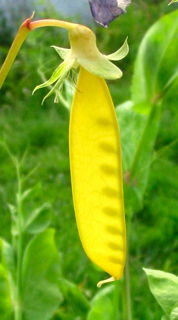
'Golden Sweet' Yellow-Podded Mange-tout pea
This is a beautiful yellow podded pea that is very sweet eaten fresh or cooked. A rare variety, so do keep your own seed if you like it.
We have grown many mange-tout peas (if you've not tried them, you eat the wide flat pods) over the years but this one has always stood out head and shoulders above the others. It is a superb mange-tout pea, with beautiful yellow pods, tall productive vines, and a delicious crisp flavour.
The flowers are purple, & the pods are a wonderful lemon yellow colour, so we actually grow it in our front garden as a decoration! The yellow pods easy to see for picking, and great both raw in salads, or cooked as a vegetable.
![]() approximately 80 seed
£
approximately 80 seed
£
Stock:
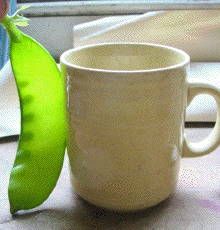 'Bijou' Giant Sugar Pea (HUGE edible-pods)
'Bijou' Giant Sugar Pea (HUGE edible-pods)
This sort of pea - real old fashioned Giant Sugar Peas with 7 inch edible pods - used to be very popular but are now almost completely extinct. The huge pods (the peas inside the pod in the photo are full-size) are sweet and juicy, and children just munch them straight off the plant.
After a 5 year project starting with a handful of peas found in a jar in a cellar, this is our reintroduction of a proper Giant Sugar Pea as used to be grown in the 1880’s. It matches the original description and engravings perfectly, even down to the pattern on the seeds and the number of seeds per gram. We hope you enjoy it! You eat the whole pod raw or cooked. They're sweet and tender - & so huge that just a few pods are enough for salad or supper.
We've had really good feedback since re-introducing it, with several people saying they would only grow this variety from now on.
Very rare, practically extinct, so a small packet, but you can easily bulk up your supply by saving a few pods worth of seed.
 approximately 40 seed, organic
£
approximately 40 seed, organic
£
Stock:
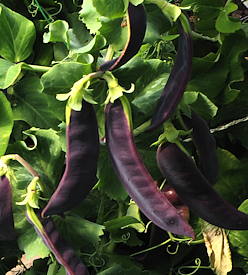 Beauregarde Purple Mangetout NEW
Beauregarde Purple Mangetout NEW
A wonderful and hardy hardy deep-purple mangetout! This is a short pea, suitable for all sorts of sites, which doesn't need much support, and make large numbers of crunchy juicy purple pods.
Originally sent to us by Ellen Rignell, who has grown and bred all sorts of seed for us for many years. She found it at a seed swap and since then reselected for a stable deep purple colour.
Only occasionally available, so keep your own seed if you like it.
 Extremely rare indeed, small packet of approx 50 seed
, organic from our farm £
Extremely rare indeed, small packet of approx 50 seed
, organic from our farm £
We have since found that it was originally created by a breeder called Michael Mazourek, who wrote to us:
Ben Thanks for your note! .... Beauregarde is from Charlie and the Chocolate Factory; "You're turning violet, Violet!". As happens when one is shelling the seed from the dry pods. Glad you like it! ... The idea of a purple pea was part wanting to be creative and part wanting to challenge the notion .. that only white flowered peas were suitable for consumption. I sought to separate the color from the bitter astringency with the hope that the peas would be more robust. The thinking was that peas have purple flowers in the wild and every winter hardy pea has purple flowers. I also started working on peas because they were part of my childhood garden along with peppers and winter squash.
~ Sugar-Snap Pea Seed ~
Sugar-snap peas are grown for their sugary, fat, edible pods - picked mature and eaten pod, peas and all.
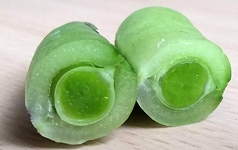 'Delikett' semi-dwarf Sugar-snap pea
'Delikett' semi-dwarf Sugar-snap pea
A pea with very fat sweet edible pods - eat the whole thing cooked or raw, just like a french bean. Grows to about 4ft tall, so best to provide some support.
They are delicious either raw or cooked and we couldn't resist eating all the trial peas! Here's a cross-section of the pods to show just how fat and succulent they are . . .
![]() about 100 seed
£
about 100 seed
£
Stock:
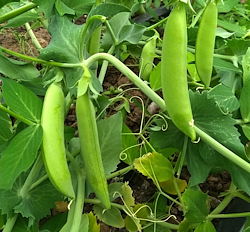
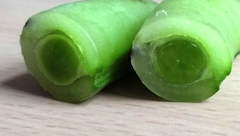
'Jessy' Dwarf Sugar-snap pea
In 2019 we added this very short pea plant that needs hardly any supports yet produces large numbers of very fat sweet juicy pods that you eat whole.
Delicious straight off the plant or cooked as you would use a french bean.
![]() about 100 seed
£
about 100 seed
£
Stock:
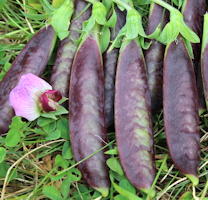 Sugar Magnolia
Sugar Magnolia
The elusive properly-purple-podded snap pea! The tall plants are purple all around, with magenta flowers and deep purple pods. Hyper tendrils for extra grip.
Sent to us by Owen Bridge of Annapolis Seeds, we have been reselecting particularly good plants for since 2019. It is incredibly rare , so we are supplying small 'starter packets' & you should save your own seed for future use. It's very easy using the instructions on this website.
Named by breeder Alan Kapuler PhD after the Grateful Dead song from the 1970 album 'American Beauty'.
 Extremely rare , starter packet of approx 40 seed
, organic £
Extremely rare , starter packet of approx 40 seed
, organic £
~ Seed for DRYING / SOUP Peas ~
Let's be clear - 'soup peas' are for use dried. They're not good fresh (far too starchy!) so you'll need to grow some normal peas too. But they do make a fantastic ingredient in soups, stews, curries and other pulse dishes. If you want a high-protein crop that can be easily grown and dried in UK conditions, then this is the one for you.
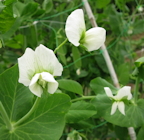 Boddingtons Soup Pea VERY RARE
Boddingtons Soup Pea VERY RARE
A productive soup pea from the Clydach valley in Wales. We haven't been able to trace much of its history, but have been impressed with its performance, particularly the extremely difficult summer of 2012.
This variety has smooth greeny-grey seeds, that make a traditional UK style pea soup or tasty mushy peas (if you prefer a darker coloured pea, look at the Latvian variety below). Allow for growth to 6 foot plus, so make frames for them as you would runner beans or climbing french beans.
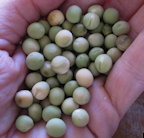 This is a small starter pack of 60 seeds for you to multiply and help preserve this variety. Pea seedsaving is very easy, and obviously (as a soup pea) they produce lots of seeds! So you should have no problem keeping back plenty to sow next year, as well as having a good crop for cooking.
This is a small starter pack of 60 seeds for you to multiply and help preserve this variety. Pea seedsaving is very easy, and obviously (as a soup pea) they produce lots of seeds! So you should have no problem keeping back plenty to sow next year, as well as having a good crop for cooking.
With all our rare peas, we recommend starting in modules to avoid losses to mice who will happily steal all your freshly planted valuable pea seed!
 approx 100 seed, organic
£
approx 100 seed, organic
£
Stock:
The Latvian pea is again very productive and tall growing, so needs sturdy supports. It has really beautiful tan seeds speckled with a darker brown, obviously great for use in soups, but also good in other dishes that use dried pulses.
Our friend Daniel makes a delicious 'hummus' with this variety. It also has pretty purple flowers which look very attractive in the garden.
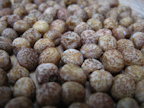 Again a smaller starter packet - but given a year or so you should be able to provide peas to most of your neighbourhood without much difficulty!
Again a smaller starter packet - but given a year or so you should be able to provide peas to most of your neighbourhood without much difficulty!
 approx 70 seed, organic
£
approx 70 seed, organic
£
Stock:
Malkuta wrote in: "My beloved wife Rita is Latvian . . .This pea is very important in her culture and was a dish cooked with fried caramelised onions, cooked in smoked pork lard, some garlic (if avalable), and served as a pulse like greeky, or rice might be today. It was served especially at Christmas time, or in erlier times, pre christian times on mid winter solstice. This is believed to bring much abundance or we might say good luck to the family. She recalls an old grandmother growing and bagging these peas to give to the family as gifts at this time of year. She also sold some to make a little money for these celebrations. Emmigrants took them abroad in the various pogroms as a memory of home."
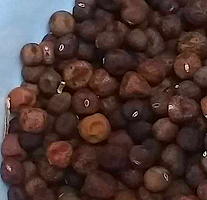 Roveja Semi-dwarf soup Pea
Roveja Semi-dwarf soup Pea
A very ancient variety of peas, today cultivated in only in a few mountainous Appenine regions in Italy. Thanks also to its relatively problem-free cultivation this variety has been rediscovered in recent years and it did well for us in Wales in 2017.
The plants are semi-dwarf - you can let them sprawl, but we'd suggest supporting them with pea sticks or low netting for the best crop. They are absolutely beautiful, with bi-coloured pink-purple flowers fading to pale pink/white as they age. They're allowed to mature and dried, then used for delicious winter soups and stews.
Tasty and beautiful! An ancient variety that is still well worth growing.
 80 seed, organic
£
80 seed, organic
£
Stock:
Mentioned by Linnaeus in 1741, this traditional soup pea is multipurpose - not just dried for soups, but sweet enough to eat fresh when very young, & also ground to make flour for bread and porridge. It's a medium-tall variety growing to around 5 foot in a typical year.
Sent to us by Jake Whitson in Sweden, who said:
“from the county to the north of us (Dalarna) where they have very hard winters, and the plants which we planted a little late survived into the winter through temperatures of -8C”
Grown in Rättvik until 1900, then thought lost until regenerated from a small sample in a seedbank.
 very rare; approx 50 seed, organic
£
very rare; approx 50 seed, organic
£
Stock:
~ Saving Pea Seed ~
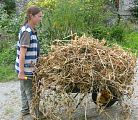
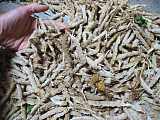
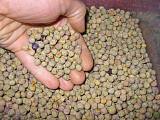
Peas don't in general cross very easily, so you can save seed from several varieties without worry. Here is our 'Golden Sweet' harvest.
But be sure that you don't plant types with similar-coloured seeds next to each other, then you'll avoid any mix ups.
Ideally pick your pea plants when
they are fairly dry - you can even just hang them on an indoor washing line if it's
persistently rainy! Then just stomp the peas out of their pods.
More detailed seed-saving instructions are included with your seeds,
so you can do all this yourself at home.






